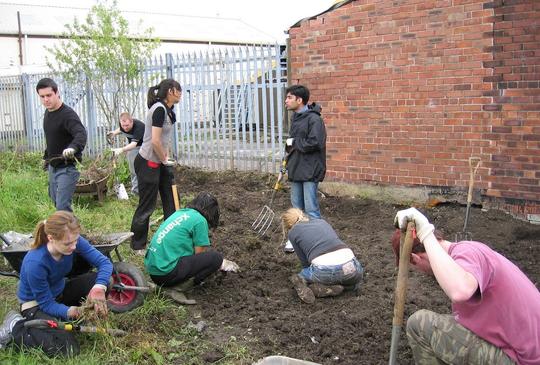
Fruitful work at Orchard 49 for Apple Day
-
Orchard 49 is nestled towards the back of Seymour Grove urban allotments in Old Trafford. A surprisingly large space, the orchard has been cultivated on a previously hard to let plot that had become overgrown and difficult to manage. In 2010 the Old Trafford Amateur Gardeners’ Society decided to turn the quiet spot into a community orchard that would showcase local heritage varieties, as well as provide an opportunity for local people to learn about growing fruit.
“One of the main reasons for designing the orchard like this is that we really want to show people that you don’t need a lot of space to grow fruit,” says Debbie Ellen who runs the orchard. “Particularly because of where the orchard is located, it’s an area [Old Trafford] where the majority of people have little outside space.”
One fence line in the orchard has an impressive 36 apple trees. “They’re all planted in horizontal cordons, where you grow the fruit up one central stem, so you can fit a lot of trees in a small space,” says Ellen. “The other advantage of doing this if you have a small space at home, is that you don’t have a massive glut of one variety of apple. This way you can avoid having too much fruit, which can lead to food waste.”

Orchard 49 boasts 55 different varieties of fruit. The majority of the trees are apple, but there’s also pear, fig, cherry, gage, damson, plum, quince, blackberries, blueberries, gooseberries and raspberries.
The orchard runs a range of workshops for the local community relating to growing fruit, including pruning, apple identification, preserving and grafting. Ellen says grafting, the technique whereby the trees are propagated, is a particularly important skill for fruit growers.
“The process is actually quite straightforward once you’ve been shown how to do it,” she says. “But it’s important to learn because it’s a much cheaper way of getting apples. Buying root stock is around £1, compared to buying a tree at a nursery, which could cost up to £20.”
The orchard also holds regular work days, which rely on local volunteers. These days can include everything from preparing the ground for planting apple and pear trees, to weeding and planting primula. The priorities for this year’s work days include building raised beds along the fence line, tending trees, keeping tree bases free of mulch and weed, and well as pruning the trees.
Another of the orchard’s activities is to hold annual Apple Days; the next is on 4 October.
Another of the orchard’s activities is to hold annual Apple Days; the next is on 4 October. These events provide an opportunity for people to taste the orchard’s heritage apples, sample freshly pressed juice, as well as buy pizzas made in the allotments’ outdoor cob oven.
The orchard was initially developed with a grant from the Local Food fund {http://www.localfoodgrants.org/}, and recently secured funding from Unicorn, the local cooperative grocery, which will enable the team to run a grafting workshop next March. But with no regular funding, the orchard is dependent on fundraisers like the Apple Days.
Ellen is also keen to encourage more volunteers to get involved. “This is the first year that we’ve really had a lot of apples, and we’ve been giving them to our volunteers,” she says. “We’ve also been considering doing a mini community-supported agriculture, which would mean people would pay a small fee to be a member of the CSA. For that, they’d be able to come and take some apples, as well as contributing to the work around twice a year.”
Perspectives essay: love food and hate waste
Contributed by Debbie Ellen and Lucy Danger
Contributor Profile
Clare is a journalist covering culture and social affairs. With a degree in law and masters’ in journalism, her work has been published in The Guardian, The Huffington Post, Digital Spy, Creative Tourist and many others. Born in Ireland, Clare lived in Luxembourg and Texas, before settling in Manchester.




